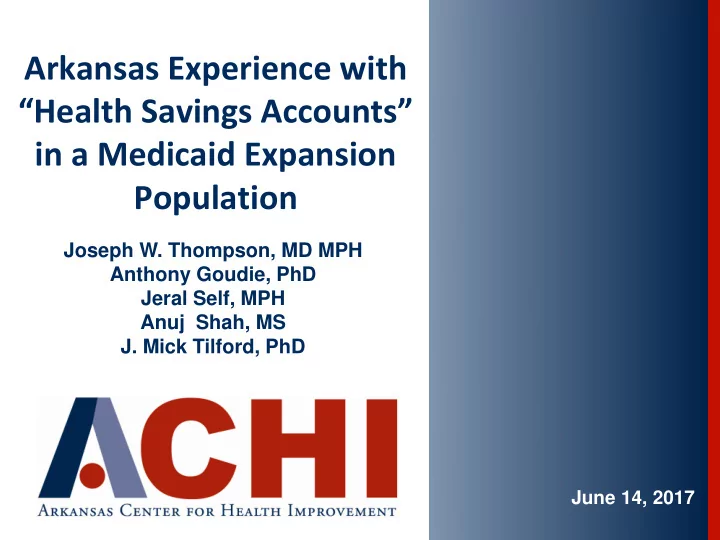

Arkansas Experience with “Health Savings Accounts” in a Medicaid Expansion Population Joseph W. Thompson, MD MPH Anthony Goudie, PhD Jeral Self, MPH Anuj Shah, MS J. Mick Tilford, PhD June 14, 2017
Background: Consumer Driven Health Care and Medicaid • Medicare Modernization Act (2003): Health Savings Accounts enabled as tax shelter associated with high deductible plans • Deficit Reduction Act (2005): 10-state demonstration of Health Opportunity Accounts with Medicaid funding (SC only participant) • Medicaid 1115 Waivers: cost-sharing strategies – MI Health Accounts – IN Personal Wellness and Responsibility Accounts – AR Health Independence Accounts
Objectives: • Profile the experience of the Arkansas Health Independence Accounts (HIA) • Assess characteristics of participating individuals • Evaluate the financial impact of the HIA • Contribute to the ongoing policy dialogue
Arkansas Policy Environment • Arkansas Health Care Independence Act – Section 1115 Waiver utilizing premium assistance to purchase plans on the private individual marketplace – Private sector cost-sharing for those >100% FPL (e.g., $8-10 for clinic visit; $4 for generic drugs) – Implemented January 1, 2014 • Health Independence Accounts (HIA) – Operational 1/1/15 – Originally for individuals 50-138% FPL / only implemented for those 100-138% FPL
Legislative Intent for HIA • Citizens to gain knowledge about appropriate healthcare services and how much those services cost • Citizens to gain experience paying cost-sharing requirements and introduction of the concept of paying premiums for insurance • Promote personal responsibility for health care decision making • Accrue funds to offset premiums and foster a cost-sharing model in the Insurance Marketplace when beneficiary incomes are over 138% FPL
Health Independence Accounts: • Individual accounts for those 100-138% FPL – Individuals required to contribute or generate a debt to the state (no collection mechanism) • 100-117% FPL $10/mo / 118-138% FPL $15/mo • Payment resulted in state-funded cost-sharing protection for following month – Activation of account gained 2 months protection followed by payment expectations – State debits account only for failed payment • State matches individual’s contribution up to $200 if timely payments / annual roll-over • Funds available for premium payments upon exit
Study Data and Methods Employed • Data: – Enrollment files for Medicaid beneficiaries between 100-138% FPL in premium assistance – Claims data from Qualified Health Plans (2014) – Financial transactions (collection and distribution) from third-party HIA administrator (2015-2016) • Individuals (N=57,079) profiled and compared for those making/not making contributions on: • Demographic characteristics • Charlson co-morbidity index • Payment contribution frequency and amounts • Cost-sharing protection received • Net economic impact – individual and programmatic
Results: Participants by Income Federal Required Made No Made At Poverty Monthly Payments Least One Level Payment Payment Total 22,184 3,332 25,516 100-117% $10 (86.9%) (13.1%) (44.7%) 27,823 3,740 31,563 118-138% $15 (88.2%) (11.9%) (55.3%) 50,007 7,072 57,079 Total (87.6%) (12.4%) (100%)
Results: Demographics of Participants Made No Made At Least Category Payments One Payment Total 19-34 24,154 (94.1%) 1,508 (5.9%) 25,664 (45.0%) Age 35-49 14,279 (88.0%) 1,954 (12.0%) 16,233 (28.4%) p<0.0001 50-64 11,572 (76.2%) 3,610 (23.8%) 15,182 (26.6%) Male 20,130 (87.7%) 2,831 (12.3%) 22,961 (40.2%) Gender Female 29,877 (87.6%) 4,241 (12.4%) 34,118 (59.8%) White 32,073 (87.9%) 4,400 (12.1%) 36,473 (63.9%) Race / Black 7,595 (87.9%) 1,050 (12.1%) 8,645 (15.2%) Ethnicity Hispanic 1,865 (85.2%) 324 (14.8%) 2,189 (3.8%) P<0.001 Other 8,474 (86.7%) 1,298 (13.3%) 9,772 (17.1%)
Results: Prior Utilization / Risk Profile • Prior hospitalization(s) greater for participants 7.1% vs 5.1% * • Prior emergency room less for participants 25.7% vs 27.7% * • Charlson Co-Morbidity Indices * * p<0.0001
Outcomes: Cost-sharing protections • A total of $476,843 in cost-sharing protections associated with payments were achieved: – median cost-sharing payment was $8 (IQR $0, $64) – mean payment of $67 (Std Dev=$141) Type Number $$ Pharmaceuticals 31,805 $289,522 Physician 9,198 $79,482 Non-MD 7,339 $59,095 Clinician Hospitals 2,884 $41,744 Other 710 $7,000 Total 51,936 $476,843 *An additional $118,294 were paid during “free” two -month start-up period
Outcomes: Economic Impact • Premium payments for the ~7,000 individuals totaled $426,670 – Median total $40 (IQR $15, $90): 4 months payments – Mean total $60 (Std Dev $141): 6 months payments • Cost-sharing protections exceeded HIA payments by $50,172 ($476,843 – 426,670) • Cost-avoidance (individual co-payment protections greater than monthly payments) was realized by 23.4% of participants • Administrative costs to maintain program and accounts were ~$9M over 18 months
Limitations Our results are based upon observational information related to individual actions; we lack information on beneficiaries’: – Health literacy related to insurance design – Awareness of program design or purpose – Experiences in program participation – Perceived value or risk of participating – Ability to anticipate cost-sharing events – Relative income stability within households – Reasons for intermittent payment patterns
Conclusions: • Introduction of “savings” accounts into Medicaid demonstrated limited participation • Medicaid beneficiaries that are likely to participate in personal “savings” accounts are likely to be older, have more conditions, and previously hospitalizations • Participating individuals demonstrated rational economic behavior with some achieving economic advantages • Operational and fiscal costs of such efforts should be considered prior to implementation
Postlude: • The Arkansas General Assembly terminated the Healthcare Independence Accounts in 2016 and replaced them with nominal monthly premiums • Individuals with account balances (n=2253) received program termination checks • No awareness of individuals directly utilizing account balances for private sector premium payments
Thank you Quality Cost Access
Recommend
More recommend